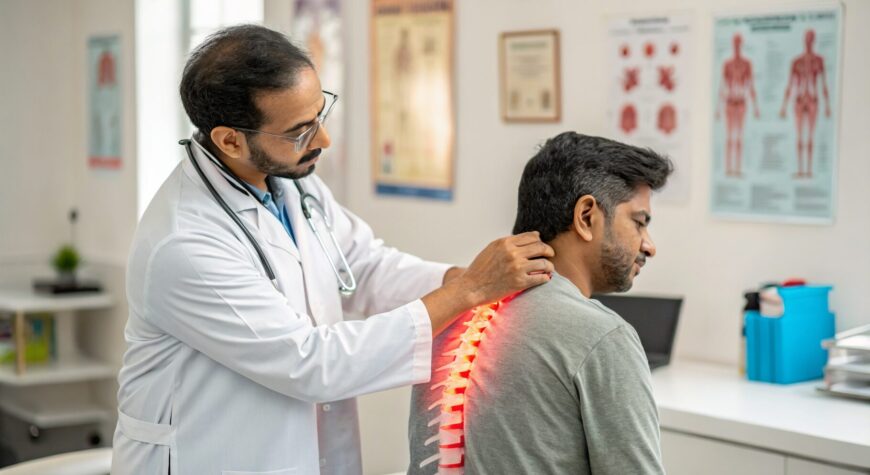What Causes Neck Pain from Cervical Spondylitis

That persistent neck ache you feel is definitely real. You feel its presence, you wrestle with its frustration, and sometimes, it just completely shuts you down. You could wake up feeling really stiff. Maybe turning your head makes a strange grinding noise, or a sudden pain shoots right down your arm.
If you recognize your own persistent neck stiffness and ache in these words, cervical Spondylitis could be the cause. That problem might have a scary name, but trust me, it’s super common. You’re definitely not by yourself here. Millions of people have a similar spondylosis experience, and understanding what is happening in your body is the first step toward finding relief.
What Exactly Is Cervical Spondylitis?
Let’s break it down into simple terms. Think of the shock absorbers in your car that wear out over many years and miles. Your spine has its own version of shock absorbers called the cervical disc, and cervical spondylosis is essentially the age-related wear and tear of these discs and joints in your neck.
As we get older, the discs in our neck can slowly lose moisture and shrink, a process known as degenerative cervical spine disease. This process can lead to more bone-on-bone contact between the vertebrae and irritation of the facet joint. This condition is also known as neck arthritis or cervical osteoarthritis, and it is an incredibly common part of aging.
It is a gradual process, but over time, it changes the structure of your neck. The body might even try to help by growing extra bone, called bone spurs, to strengthen the spine. These spurs can sometimes end up narrowing the space for your spinal cord and nerves, leading to further complications.
Are You Noticing These Symptoms?
Do any of these sensations sound familiar? The symptoms of cervical spondylosis can range from mildly annoying to severely disruptive. People often experience a combination of signs that something is not right with their neck health.
Many people find their cervical spondylosis symptoms are worse in the morning or after being in one position for a long time. It could be after a long day hunched over a computer or after a drive. Here are some of the most common red flags to look for.
- Persistent Neck Pain and Stiffness: This is the hallmark symptom, which can include pain in the neck itself. The discomfort might be a constant dull ache or a sharp, stabbing feeling that gets worse with movement.
- A Grinding or Popping Sound: You may hear or feel a grinding sensation, called crepitus, when you turn your head. It is caused by roughened joint surfaces rubbing against each other.
- Headaches: These headaches often start at the base of the skull and radiate up the back of the head. They are sometimes called cervicogenic headaches.
- Radiating Pain (Cervical Radiculopathy): The pain does not always stay in the neck. If a bone spur or herniated disc presses on a nerve root, you may develop cervical radiculopathy, causing pain to travel into your shoulders, arms, hands, and even fingers.
- Numbness and Tingling: You might feel a pins and needles sensation in your arms or hands. This often points to nerve irritation consistent with cervical radiculopathy.
- Muscle Weakness: Difficulty lifting objects or a weak grip can also occur. This is a more serious sign that a nerve might be significantly compressed.
- Coordination and Balance Issues (Cervical Myelopathy): In more advanced cases, pressure on the spinal cord itself can lead to cervical myelopathy. This is a serious condition characterized by difficulty walking, loss of balance, and problems with fine motor skills like buttoning a shirt. It may also affect bladder or bowel control.
These symptoms develop because the changes in your spine can start to put pressure on the spinal nerves. This compression is what causes the pain, numbness, and weakness to spread. Understanding these specific symptoms helps you communicate more effectively with your healthcare provider.
What Causes This Neck Wear and Tear?
You might be wondering why this is happening to you. There is not a single cause for this condition, which is a general term for age-related changes in the neck. It is usually a combination of factors, with age being the biggest one, but your daily life and history also play a significant role.
The Aging Process
Just like gray hair and wrinkles, changes in our spine are a natural part of getting older. As institutions like the Mayo Clinic explain, discs can dehydrate and shrink, leading to a loss of that spongy cushion between your vertebrae. Your body, in its effort to stabilize your neck, sometimes forms bone spurs, which can contribute to the problem.
This process is gradual and happens to almost everyone to some degree. For many, it causes no symptoms at all. For others, these changes are enough to start causing pain and stiffness that affect their quality of life.
Your Daily Habits Matter
The way you hold your body every day can have a huge impact. Constantly looking down at your phone puts a tremendous amount of strain on the cervical spine. Your head is heavy, and tilting it forward for hours at a time accelerates wear and tear.
Jobs that involve repetitive neck motions, awkward positioning, or overhead work also increase the risk. Think of painters, drivers, or assembly line workers. These occupations can put consistent stress on the delicate structures of the neck over many years.
Previous Injuries
A past injury from a fall, car accident, or sports can speed up the aging process in your neck. Even an injury from many years ago can have long-lasting effects. It might damage a cervical disc or ligament, setting the stage for earlier or more advanced degenerative changes later in life.
The initial injury may have healed, but the underlying damage can make that area of your spine more vulnerable. This is why it is so important to properly care for any neck injury when it happens. Seeking prompt medical evaluation can make a difference in your long-term neck health.
Other Risk Factors
Genetics can play a part, too. If your parents had significant neck issues, you might be more likely to develop them. Some research from a systematic review of studies suggests a genetic component to disc degeneration.
Smoking is another big risk factor. It reduces blood flow to the discs in your spine, which can rob them of essential nutrients and make them break down faster. Maintaining a healthy weight and staying active can also help reduce the strain on your spine.
Getting a Clear Diagnosis for Cervical Spondylitis
Getting to the bottom of your neck pain starts with a conversation with a healthcare professional. They will listen to your story, ask about your symptoms, and perform a physical exam. This process is about gathering clues to understand exactly what is going on.
During the exam, your doctor will likely check a few things. They will assess your neck’s range of motion, test your reflexes, muscle strength, and sensation to see if any nerves are affected. A physical therapist may also be involved in this initial assessment to evaluate your movement patterns.
To get a clearer picture of what is happening inside your neck, your doctor may suggest some imaging tests. Many medical education programs, like those at the Mayo Clinic College of Medicine and Science, train physicians to use these tools effectively. These tests help confirm a diagnosis and rule out other potential causes of your neck pain.
| Imaging Test | What It Shows |
| X-ray | Can reveal bone spurs, arthritis, and the loss of disc height between your vertebrae. It is a great starting point for assessing bone structure. |
| MRI Scan | Uses powerful magnets to create detailed images of your soft tissues. It is excellent for showing herniated discs, pinched nerves, and conditions like cervical spondylotic myelopathy. |
| CT Scan | A ct scan provides a more detailed, cross-sectional view of your bones than a standard X-ray. It is good for seeing the spinal canal in detail and assessing complex bone anatomy. |
These tests provide a roadmap for creating the most effective, patient-centered care plan for you. The findings will guide whether nonsurgical treatments or more advanced interventions are necessary.
Your Path to Feeling Better: Treatment Options
The good news is that most people with this condition find relief with conservative, nonsurgical treatments. The goal is to reduce pain, improve your neck’s function, and prevent any further injury. You have a lot of options, and your path to feeling better often involves a combination of strategies.
At-Home Care and Lifestyle Changes
Some of the most powerful tools are things you can do yourself. Simple changes can make a big difference in managing your day-to-day symptoms. Using heat can help relax sore muscles, while a cold pack can reduce inflammation after an activity.
Gentle neck stretches and strengthening exercises can improve flexibility and support your spine. Improving your posture is also vital. Make sure your workstation is set up ergonomically and try to be mindful of how you hold your head when using your phone or reading.
Physiotherapy and Professional Guidance
Professional care is often the cornerstone of effective management. A physical therapist can teach you specific exercises to strengthen weak neck muscles and improve your range of motion. They act as your coach, guiding you through a program designed just for you.
Many programs focused on graduate medical education emphasize the importance of physical therapy as a first-line treatment. The continuous professional development of therapists ensures they use the latest techniques. Their goal is to empower you with the tools to manage your condition independently.
When Medication and Injections Might Help
Sometimes, you might need help managing flare-ups. Over-the-counter pain relievers like ibuprofen or naproxen can help reduce both pain and inflammation. Your doctor might also recommend a muscle relaxant if you are experiencing severe muscle spasms.
For more targeted relief from cervical radiculopathy, your doctor might suggest a steroid injection. An epidural steroid injection places strong anti-inflammatory medicine directly around the irritated nerve roots. This can provide significant, though often temporary, relief and create a window for physical therapy to be more effective.
Is Surgery an Option?
Surgery is rarely the first step. It is typically reserved for people with severe symptoms of cervical myelopathy or progressive neurological deficits that do not improve with conservative care. This could include significant weakness in the arms or hands or worsening balance problems.
The goal of surgery is to decompress the spinal cord or nerve roots. A spine surg specialist might perform a procedure like an anterior cervical discectomy and fusion (ACDF). During an anterior cervical discectomy, the surgeon removes the damaged disc or bone spurs from the front of the neck to relieve pressure.
Before considering surgery, it is important to discuss all options with your doctor. Sometimes, a clinical trial might be an option for new or less invasive procedures. All research involving human subjects, as a paper from the Mayo Clinic Graduate School of Biomedical Sciences might explain, is overseen by an institutional review board to ensure patient safety.
Conclusion
Living with neck pain can feel overwhelming, but a diagnosis of cervical Spondylitis is not a life sentence of pain. It is an explanation for what you are feeling and a starting point for action. Understanding that this condition is a manageable part of the body’s natural aging process is the first step toward taking control.
By combining self-care, lifestyle adjustments, and professional help, you can significantly reduce your pain. Working with a physical therapist or other healthcare providers can help you get back to enjoying your life. Your journey to relief begins with knowledge and a proactive approach to your neck health.
